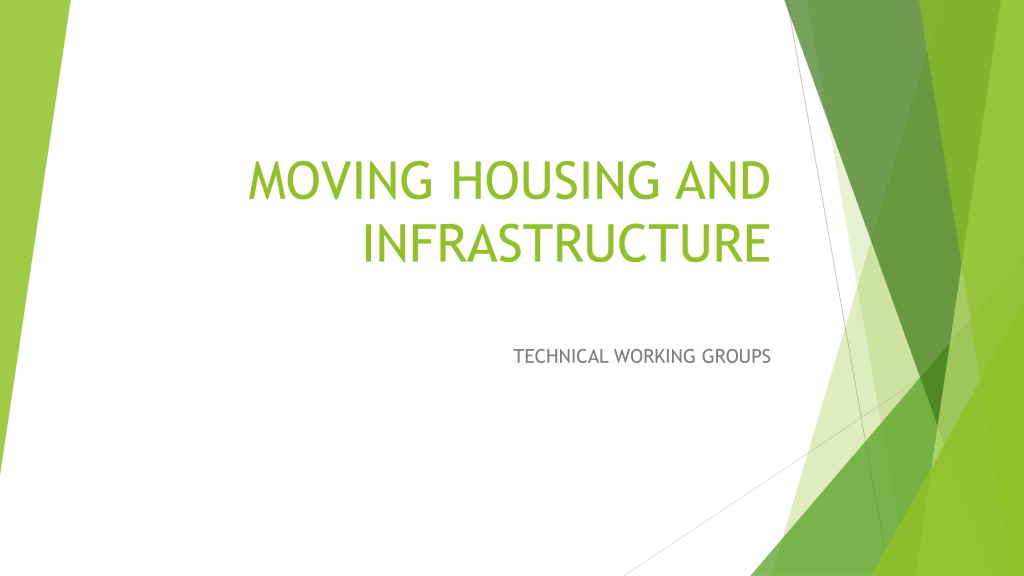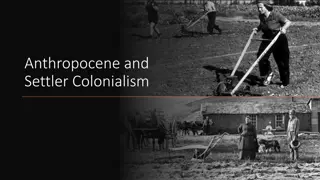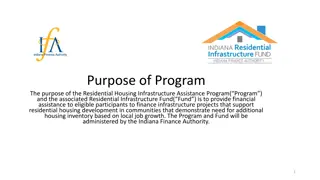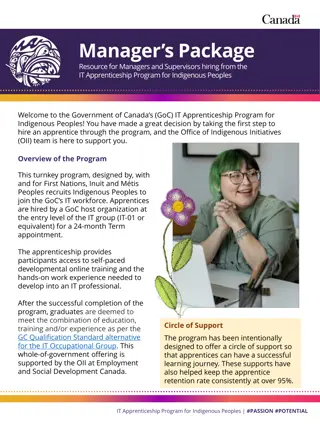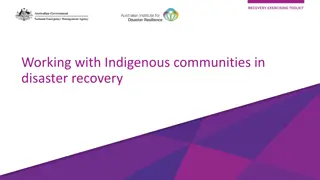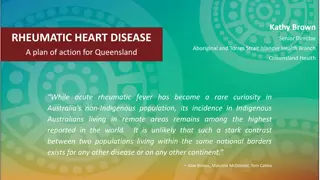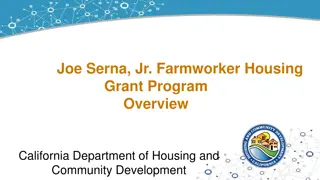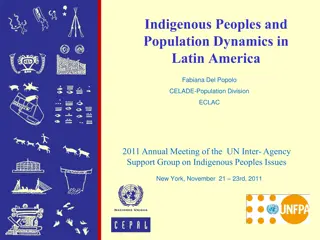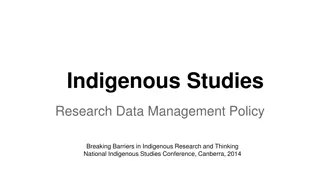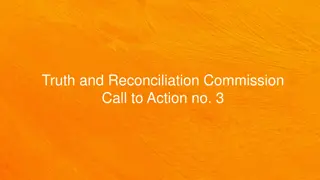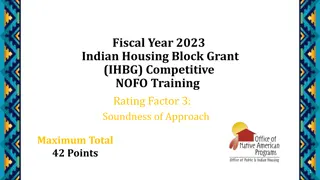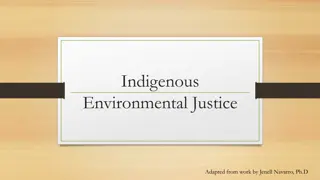Technical Working Groups in Indigenous Housing and Infrastructure Development
National and regional technical working groups play vital roles in advancing housing and infrastructure development among Indigenous communities in Canada. Examples include the Ontario First Nations Technical Services Corporation (OFNTSC) and the First Nations Technical Services Advisory Group Inc. (TSAG), providing essential services, training, and support for sustainable community growth and environmental stewardship.
Uploaded on Sep 11, 2024 | 1 Views
Download Presentation

Please find below an Image/Link to download the presentation.
The content on the website is provided AS IS for your information and personal use only. It may not be sold, licensed, or shared on other websites without obtaining consent from the author. Download presentation by click this link. If you encounter any issues during the download, it is possible that the publisher has removed the file from their server.
E N D
Presentation Transcript
MOVING HOUSING AND INFRASTRUCTURE TECHNICAL WORKING GROUPS
The National TECHNICAL WORKING GROUP The Chiefs Committee on Housing and Infrastructure Consisting of 10 Chiefs appointed by their Regional Chief Portfolio Holder on Housing and Infrastructure Terms of Reference 2 Technical committees for housing and for water/infrastructure Face to face meetings and teleconferences Advocate on broad national issues.
Examples of Regional Institutions Ontario First Nations Technical Services Corporation 1989-1995: Chiefs of Ontario negotiates with Indian and Northern Affairs Canada in response to plans for devolution. Work begins to transfer responsibilities from the Indian Inspection Unit to Ontario First Nations Technical Services Corporation (OFNTSC). 1995: In February of 95, Chiefs of Ontario passes a resolution to cease operations of the Indian Inspector Unit and OFNTSC is officially incorporated as a non-profit corporation, thereby becoming the first organization of its kind serving First Nations in Canada.
Examples of Regional Institutions Ontario First Nations Technical Services Corporation The OFNTSC is a technical advisory service for Tribal Councils and Ontario First Nations. The OFNTSC provides a number of services in relation to the needs of communities. The services can be broken down into these service areas: Engineering Water/Wastewater Fuel Systems Management Emergency Management Environment Fire and Safety Housing Infrastructure Operations and Maintenance Communications Offices Toronto and Thunder Bay, Head Office Mississaugas of New Credit www.ofntsc.org
First Nations Technical Services Advisory Group Inc.(TSAG) TSAG s history began in 1996 to develop, build and deliver core technical services to First Nation Communities in Alberta. On November 19, 1996 TSAG received its mandate from the Chiefs of Alberta at the Chiefs Summit V. TSAG is an organization created by the Chiefs of Alberta and provides technical support and training to First Nations in the treaty 6, 7 & 8 regions. TSAG is a not- for-profit First Nations organization. Its purpose is to assist Alberta First Nations gain the proper tools and knowledge that will help to achieve and maintain high standards in technology and services within the community. They provide professional technical and advisory services for Alberta First Nations to help build a future within the community. Through its programs and services, their goal is to empower communities to gain the confidence and resources needed for a healthy environment. They offer programs that focus on the community as a whole as well as programs targeted at educating youth.
TSAG Services Asset Management Circuit Rider Training Program Environmental management Fire Protection and Prevention Housing Information Technology Youth Initiatives Annual Conference http://www.tsag.net/index.html
BC Technical Working Group Housing & Infrastructure Evolution BC Technical Working Group 2016 National Housing and Infrastructure Reform 2008 MOU Technical Communications Working Group 2008 FN Housing and Infrastructure Memorandum of Understanding 2005 Transformative Change Accord
BC Housing and Infrastructure Working Groups The Aboriginal Capital Committee The Aboriginal Housing Committee
A BC Housing & Infrastructure Technical Working Group
BC Technical Working Group functions Transition from the 10 year plan in the BC Housing MoU signed in 2008 Liaise with the National Plan and Chiefs Committee on Housing and Infrastructure Develop framework for the BC portion of the FN Housing and Infrastructure Authority
Real Change It s been a long time coming
Real Change In 1948 Jules Sioui, a First Nations leader from Quebec called on government to give up control over Indian Affairs No decision about Indians without Indians
Real Change In 1965 Martin O Connell wrote a paper for the Department of Indian Affairs on housing on-reserves. He recommended: The establishment of modern self-government structures, must go hand in hand with Indian participation in the planning and execution of development policies and programs, including housing.
Real Change In 1972 the National Indian Brotherhood Declaration on Housing called for more control over housing: The housing and community building process is not Indian. It does not spring from the Indian nor does it add to skills, livelihood, cultural pride or identity.
Real Change In September 15, 2014, Kasabonika Lake First Nations councillor, Mike Morris spoke to the Standing Senate Committee on Aboriginal Peoples on housing conditions on reserves: For me, and I m sure other First Nations, we don t want to have to depend on the government It s time to meet and sit down and build a new relationship because they are imposing their legislation on us. I don t know by what right they do that.
Real Change In July 2016 Minister Carolyn Bennett, Indigenous and Northern Affairs, told the CCoHI at the AFN national meeting in Niagara Falls: Think big Think outside the box Think building your own housing institutions Think replacing CMHC Think maybe a First Nations CMHC
Real Change The 2016 Public Policy Forum recommended: Explore the creation of a First Nations-led organization(s) with responsibility for on-reserve housing.
Real Change In a paper Harold Calla wrote for this 2017 forum he said we need to provide direction. We need to take the first steps. We need to take the lead. Lay out the objectives of a First Nations Housing Authority in British Columbia State how it will improve housing for First Nations people Describe the new relationships between Canada, the province, First Nations and the institution Show how this initiative could replace the services and resources offered by INAC and other government agencies SHOW THE SOLUTIONS
